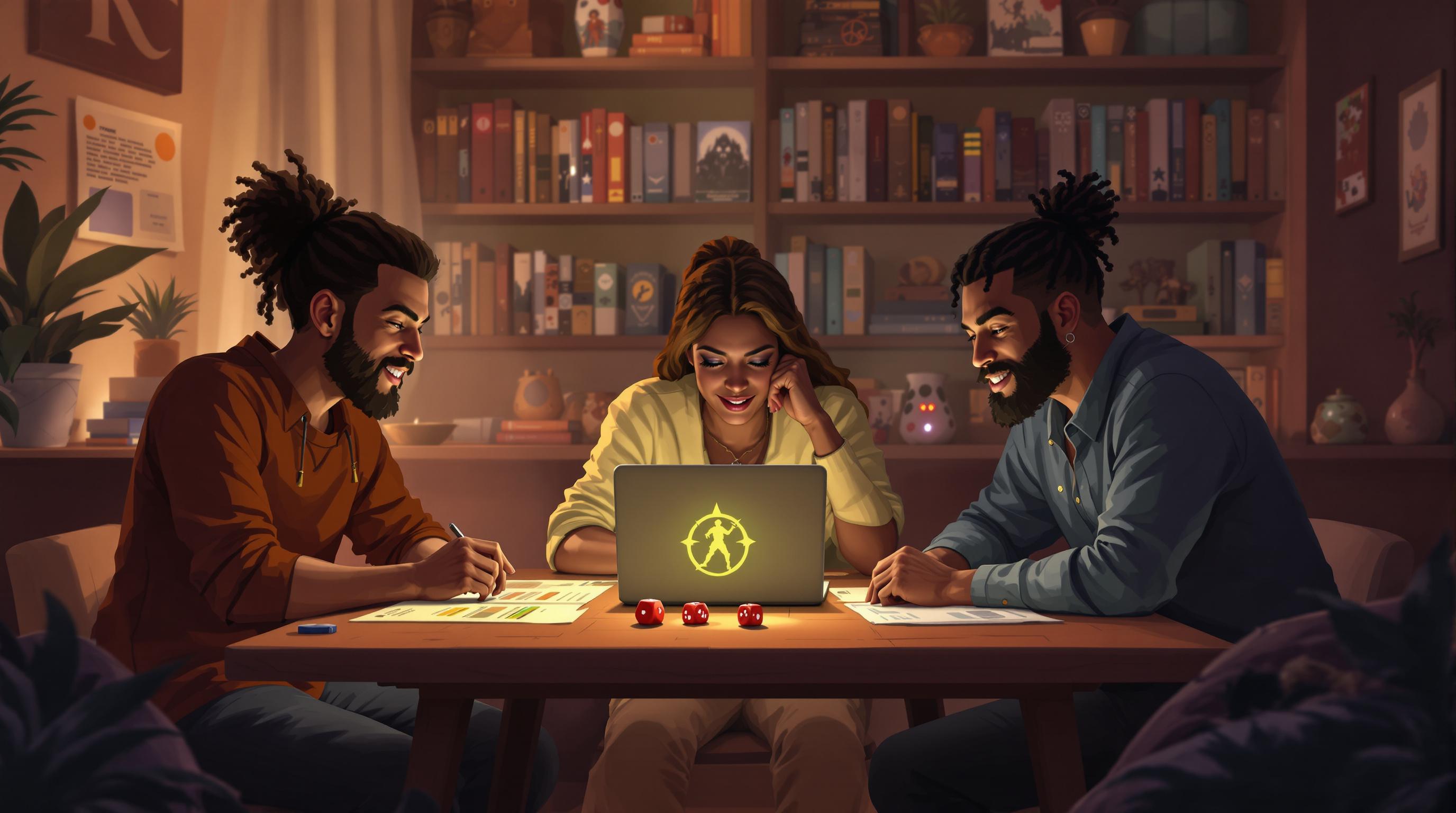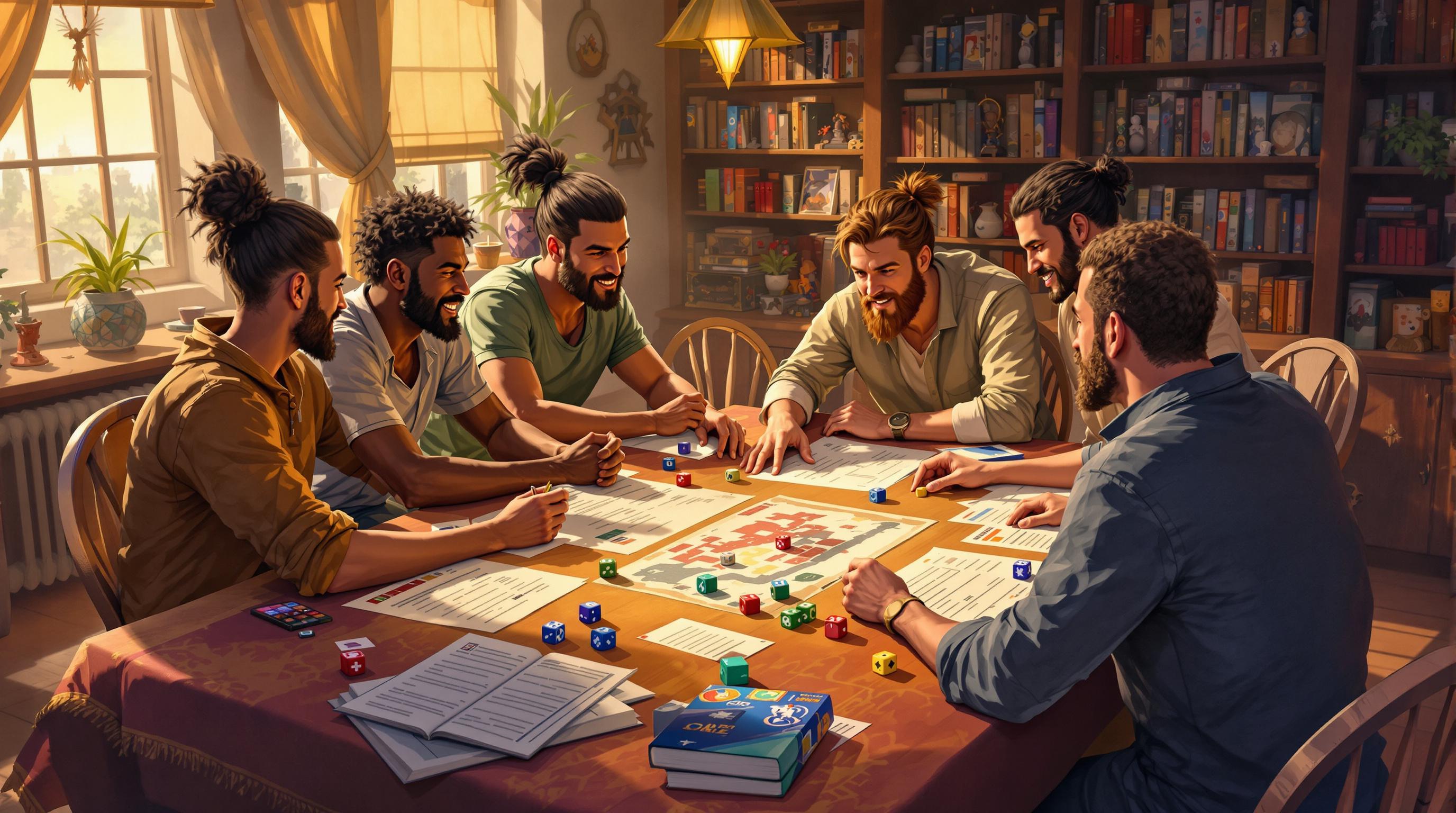Plot twists can make RPG campaigns unforgettable. They surprise players, deepen the story, and create emotional moments they’ll talk about for years. Here’s how plot twists work and how Game Masters (GMs) can use them effectively:
- What makes a good twist? It’s surprising yet logical, respects player choices, and ties into the story’s themes.
- Examples of twists: Hidden identities, artifact revelations, and time travel events that reshape the game.
- Key ingredients: Foreshadowing, timing, player agency, and narrative consistency.
- Avoid mistakes: Don’t overload with twists or break established lore.
- Planning tips: Connect twists to character backstories, plant subtle hints, and adapt based on player actions.
- Advanced techniques: Layer multiple twists and improvise during gameplay for dynamic storytelling.
Great twists rely on preparation, player involvement, and maintaining story coherence. Use tools like the TTRPG Games Directory to find systems that support engaging narratives.
| Key Element | Purpose | Example |
|---|---|---|
| Foreshadowing | Builds consistency | Subtle NPC hints or environmental clues |
| Player Agency | Keeps players invested | Choices that shape twist outcomes |
| Timing | Enhances emotional impact | Reveal twists during climactic moments |
Mastering plot twists can elevate your RPG storytelling and keep players hooked.
What Makes a Good Plot Twist in RPGs?
Defining Plot Twists in RPGs
In RPGs, plot twists are moments that catch players off guard but still feel logical within the story. They’re shaped by player choices and should push players to rethink their strategies [2]. Two key factors determine how effective a twist is:
| Factor | Description | Impact on Story |
|---|---|---|
| Player Agency & Narrative Logic | Choices feel meaningful and connect to the overall story | Creates satisfying "aha" moments and keeps players engaged |
| Emotional Impact | Delivers genuine surprise or revelation | Pulls players deeper into the story and raises the stakes |
The Role of Plot Twists in RPG Storytelling
Plot twists elevate the storytelling experience by challenging expectations and transforming straightforward missions into memorable adventures [1]. Let’s break this down with examples:
In Final Fantasy 6, the shift to the World of Ruin completely alters the game’s narrative and emotional tone. Similarly, Chrono Trigger delivers a shocking twist with Crono’s death, forcing players to confront new stakes and reshape their approach [3].
Tabletop RPGs also thrive on twists, where a sudden betrayal or hidden agenda can redefine an entire campaign. These moments can shift player objectives, create tension, and deepen emotional connections to the story.
To craft twists that resonate, Game Masters should weave in subtle foreshadowing, introduce NPCs with layered motivations, and ensure surprises align with the campaign’s themes.
"Plot twists add depth by introducing unexpected elements that challenge players' assumptions and strategies. They keep players engaged by creating suspense and curiosity, encouraging them to re-evaluate their understanding of the story." [1]
The best twists feel like natural extensions of the story. They respect the players’ choices while adding layers to the narrative [1][5].
How to Create Strong Plot Twists
Key Ingredients of a Good Plot Twist
Crafting engaging plot twists in RPGs requires attention to detail and a solid understanding of your story's framework. Twists should feel natural within the established lore, keeping players immersed and intrigued.
| Element | Purpose | How to Execute |
|---|---|---|
| Foreshadowing | Builds narrative consistency | Add subtle hints in NPC dialogue or events |
| Timing | Enhances emotional impact | Unveil twists at key story moments |
| Player Agency | Keeps players invested | Offer meaningful choices after the twist |
| Narrative Logic | Ensures credibility | Tie twists to existing lore and story events |
Foreshadowing is especially powerful when done subtly. For example, in Chrono Trigger, small details in character interactions and environmental storytelling hint at major plot developments, preparing players without giving too much away [3].
Common Mistakes to Avoid
Game Masters often stumble into pitfalls when designing plot twists. Avoiding these missteps is essential for maintaining both the story's integrity and the players' trust.
One major mistake is relying on too many twists. Overloading your story with surprises can dilute their impact and make the narrative feel forced. Focus on creating twists that truly add depth and meaning to your story.
Another frequent error is ignoring established rules or lore. Twists that contradict the game world’s logic can break immersion and frustrate players.
Here are some tips to sidestep these issues:
- Plan from the end backward: Start with how the twist resolves and work your way back to ensure a seamless setup.
- Reveal information gradually: Build suspense by layering hints, much like Final Fantasy 6 does with its World of Ruin twist [3].
- Gauge player reactions: Pay attention to how players respond to subtle clues and adjust your storytelling approach accordingly.
Adding Plot Twists to RPG Campaigns
Planning and Adapting Plot Twists
Careful preparation is essential to make plot twists enhance your RPG campaign rather than derail it. Begin by outlining the major story beats and weaving twists into the overall narrative. Tie these twists to player character (PC) backstories to create a stronger emotional connection, and scatter subtle hints throughout the campaign to encourage organic discovery.
| Planning Phase | Key Actions |
|---|---|
| Story Planning | Outline key story beats and plant subtle hints. |
| Character Integration | Connect twists to PC backstories for impact. |
Once the foundation is set, the challenge shifts to adjusting twists in real time during gameplay. Player decisions can take the story in unexpected directions, so being flexible is crucial. Pay attention to player theories and incorporate their ideas where it fits. This approach keeps twists engaging while respecting the players' contributions to the narrative.
For inspiration, exploring narrative-heavy games listed in the TTRPG Games Directory can provide ideas for twists that suit various genres.
Tips for adjusting twists on the fly:
- Adjust twists based on player theories and engagement levels.
- Keep track of player discoveries to maintain consistency.
- Balance the element of surprise with moments that reward player intuition.
- Ensure players have meaningful choices in how twists play out.
sbb-itb-b8b00a5
Advanced Plot Twist Techniques for GMs
Improvising Plot Twists During Play
Planning twists ahead of time is useful, but some of the most memorable surprises come from reacting to the unexpected during gameplay. By paying attention to players' actions, GMs can naturally shape the story, adding new layers while keeping the overall narrative consistent.
| Improvisation Element | How to Use It |
|---|---|
| Player Actions | Turn unexpected decisions into new story branches |
| Story Management | Keep the narrative coherent as surprises unfold |
| Narrative Development | Adjust the storyline based on player choices |
Using Multiple Twists in a Campaign
Once you're comfortable improvising, you can elevate your storytelling by layering twists throughout the campaign. This approach creates depth and keeps players guessing. A strong multi-twist structure typically includes:
- Foundation Layer: Start with small, seemingly unimportant events or details that will later take on greater meaning.
- Intermediate Revelations: Introduce smaller twists that hint at larger mysteries while being impactful on their own.
- Major Plot Shifts: Include significant twists that completely alter players' understanding of the world. These should tie back to earlier hints for maximum effect.
For ideas on how to structure complex narratives, check out the TTRPG Games Directory. It showcases examples from various genres and systems, offering plenty of inspiration.
| Twist Layer | Role in the Campaign |
|---|---|
| Minor Twists | Spark curiosity early on |
| Supporting Reveals | Add depth and intrigue in the middle |
| Major Revelations | Shift the story dramatically toward the end |
When layering twists, keep track of how each one connects to the others. This ensures every revelation enhances the story without causing inconsistencies. With these techniques, your campaigns will stay unpredictable and keep players fully immersed in the adventure.
Creating Plot Twist Ideas on the Fly - RPG Storytelling Tips
Using Tools Like TTRPG Games Directory

Finding the right RPG system to craft engaging plot twists becomes much simpler with resources like the TTRPG Games Directory. This tool acts as a go-to guide for Game Masters (GMs) looking to enhance their storytelling.
When browsing for systems that support dynamic plot twists, here are some key features to focus on:
| Feature Type | What to Look For |
|---|---|
| Storytelling Flexibility | Systems with modular storylines and adjustable plot structures |
| Player Decision Impact | Games that emphasize character-driven choices and their consequences |
| GM Support Tools | Mechanics that help GMs handle unexpected story developments |
| Narrative Depth | Systems built to accommodate complex and layered storytelling |
The directory highlights RPG systems tailored for narrative surprises. For example, Fate Core is excellent for fluid storytelling, while Apocalypse World offers strong mechanics for weaving in unexpected story elements.
To make the most of the directory for planning plot twists, try these approaches:
- Compare game descriptions and mechanics: Look for systems that align with your storytelling goals.
- Match complexity with your needs: Consider how intricate or straightforward your twists need to be.
- Explore a range of systems: Check out both well-known classics and lesser-known indie games for fresh inspiration.
The directory’s categorization tools are particularly helpful for narrowing down options. Whether you’re planning character reveals or world-altering events, you can find systems designed to support your specific storytelling needs.
For GMs new to incorporating plot twists, the directory offers valuable insights into systems with built-in tools for narrative development. Many of these games include mechanics aimed at creating surprising yet cohesive storylines.
Use the directory’s filters to find games that match your group's experience level and preferred genre. This ensures the system not only supports your plot twists but also aligns with your players’ interests.
| Campaign Type | Recommended System Features |
|---|---|
| Mystery-Focused | Investigation mechanics, tools for managing clues |
| Character-Driven | Personality development systems, relationship-building mechanics |
| Epic Revelations | World-building tools, faction-based mechanics |
| Political Intrigue | Frameworks for social interaction, systems for tracking consequences |
Conclusion: Make Your RPG Stories Unforgettable
This guide has shown how well-crafted plot twists can transform RPG narratives, turning campaigns into experiences players will talk about for years. Plot twists thrive on a mix of surprise, logical storytelling, and player involvement. The most impactful twists come from subtle hints, seamless integration into the story, and meaningful ties to player decisions.
Careful planning ensures these twists enhance the game without taking away player freedom. Here are some key elements to consider:
| Twist Element | How to Implement | What It Achieves |
|---|---|---|
| Foreshadowing | Use small environmental details or NPC cues | Gives players satisfying "aha" moments |
| Player Integration | Tie twists to character backstories | Builds emotional connections |
| Story Consistency | Stick to established themes and symbols | Keeps the narrative believable |
A well-executed twist can take a campaign from good to unforgettable [4]. By focusing on engaging storytelling and involving your players, you can create arcs that stick with them long after the game ends [2].
To further hone your storytelling, check out resources like the TTRPG Games Directory for ideas and tools. Whether you're revealing hidden truths about a character or reshaping the game world, keeping your players invested and your story consistent will create those unforgettable moments where everyone is on the edge of their seat.


